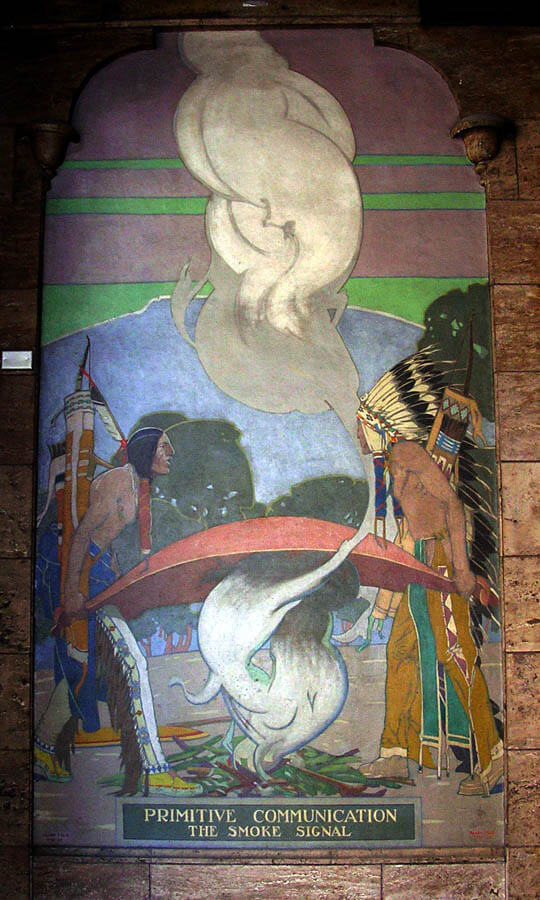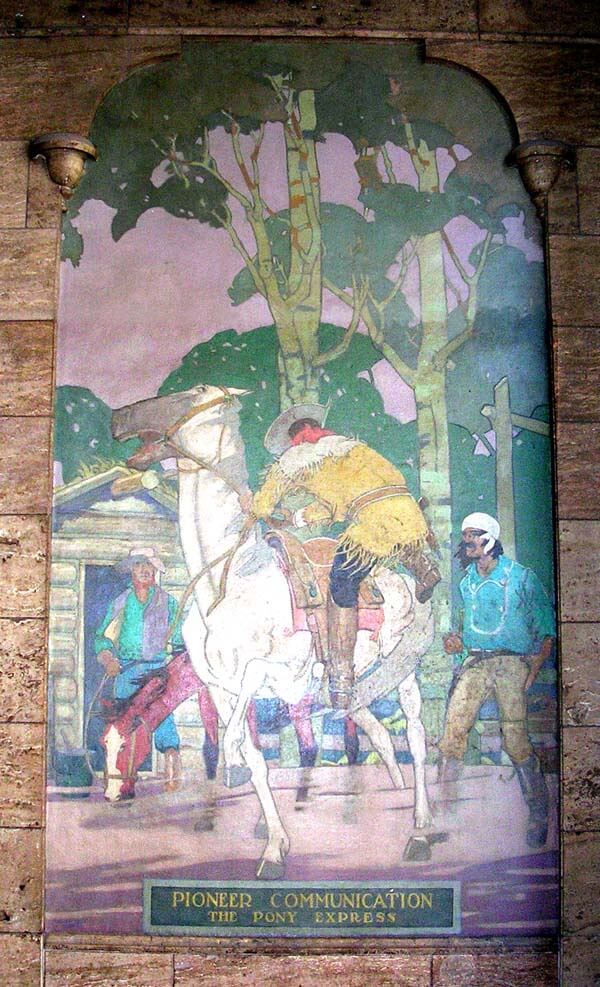
Allen Tupper True Mural, Primitive Communication - The Smoke Signal (THG file photo)
931 14th St.
Curtis Street Outer Lobby
Primitive Communication – The Smoke Signal
“The smoke signal was one of the earliest types of communication on the North American continent. A fire was smothered with green brush and the smoke was broken by a blanket into various sized clouds to convey the message. Possibly messages were sent in this way on the site of the New Telephone building; for here were once located the camps of the Arapahoe Indians.”Notes: See our sections within Site History and Local Communications History for more on the Arapaho Indians and smoke signals.

Allen Tupper True Mural, Primitive Communication - The Pony Express (THG file photo)
Pioneer Communication – The Pony Express
“In the 1860s the Pony Express carried the mail over mountain and Indian wilderness. The riders and station keepers won undying fame for getting the message through, regardless of hardship or danger.“The new Telephone Building now occupies the very spot which tradition says was once the site of the corrals of the old Pony Express.”
Notes: In fact, the Pony Express did not stop in Denver; the closest it came was Julesburg, Colorado. There was another mail (and stage) route from Leavenworth, Kansas, to Denver. See our Local Communications History section for more details.
(Please note that the italicized text accompanying the murals is adapted from a 1929 pamphlet put out by the telephone company to promote the murals and the building.)
To continue the online tour, click here.
Exhibit Entry | Site History | Local Com History | Architecture | True Murals | Building Tour 14th St Outer | 14th St Inner | Curtis St Outer | Curtis St Inner | Additional Murals
931 14th St.
Curtis Street Outer Lobby

Allen Tupper True Mural, Primitive Communication - The Smoke Signal (THG file photo)
Primitive Communication – The Smoke Signal
“The smoke signal was one of the earliest types of communication on the North American continent. A fire was smothered with green brush and the smoke was broken by a blanket into various sized clouds to convey the message. Possibly messages were sent in this way on the site of the New Telephone building; for here were once located the camps of the Arapahoe Indians.”Notes: See our sections within Site History and Local Communications History for more on the Arapaho Indians and smoke signals.

Allen Tupper True Mural, Primitive Communication - The Pony Express (THG file photo)
Pioneer Communication – The Pony Express
“In the 1860s the Pony Express carried the mail over mountain and Indian wilderness. The riders and station keepers won undying fame for getting the message through, regardless of hardship or danger.“The new Telephone Building now occupies the very spot which tradition says was once the site of the corrals of the old Pony Express.”
Notes: In fact, the Pony Express did not stop in Denver; the closest it came was Julesburg, Colorado. There was another mail (and stage) route from Leavenworth, Kansas, to Denver. See our Local Communications History section for more details.
(Please note that the italicized text accompanying the murals is adapted from a 1929 pamphlet put out by the telephone company to promote the murals and the building.)
To continue the online tour, click here.
back to top
back to 14th St Inner Lobby
on to Curtis St Inner Lobby
Exhibit Entry | Site History | Local Com History | Architecture | True Murals | Building Tour
14th St Outer | 14th St Inner | Curtis St Outer | Curtis St Inner | Additional Murals
